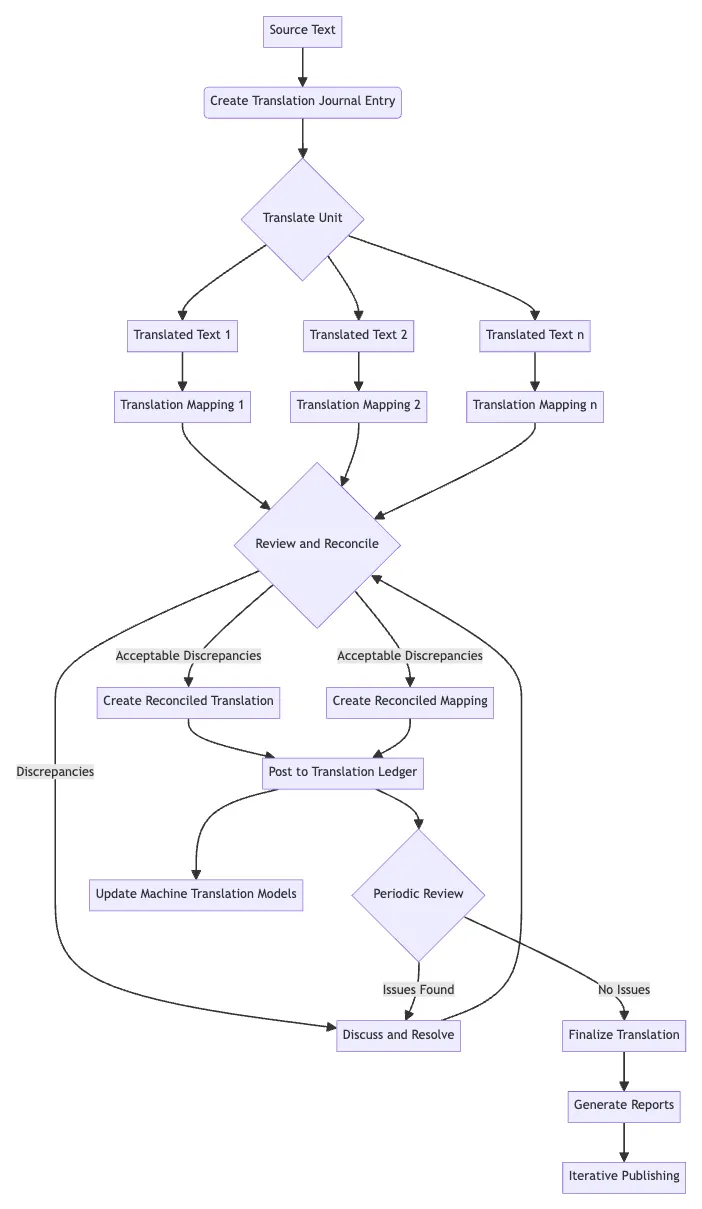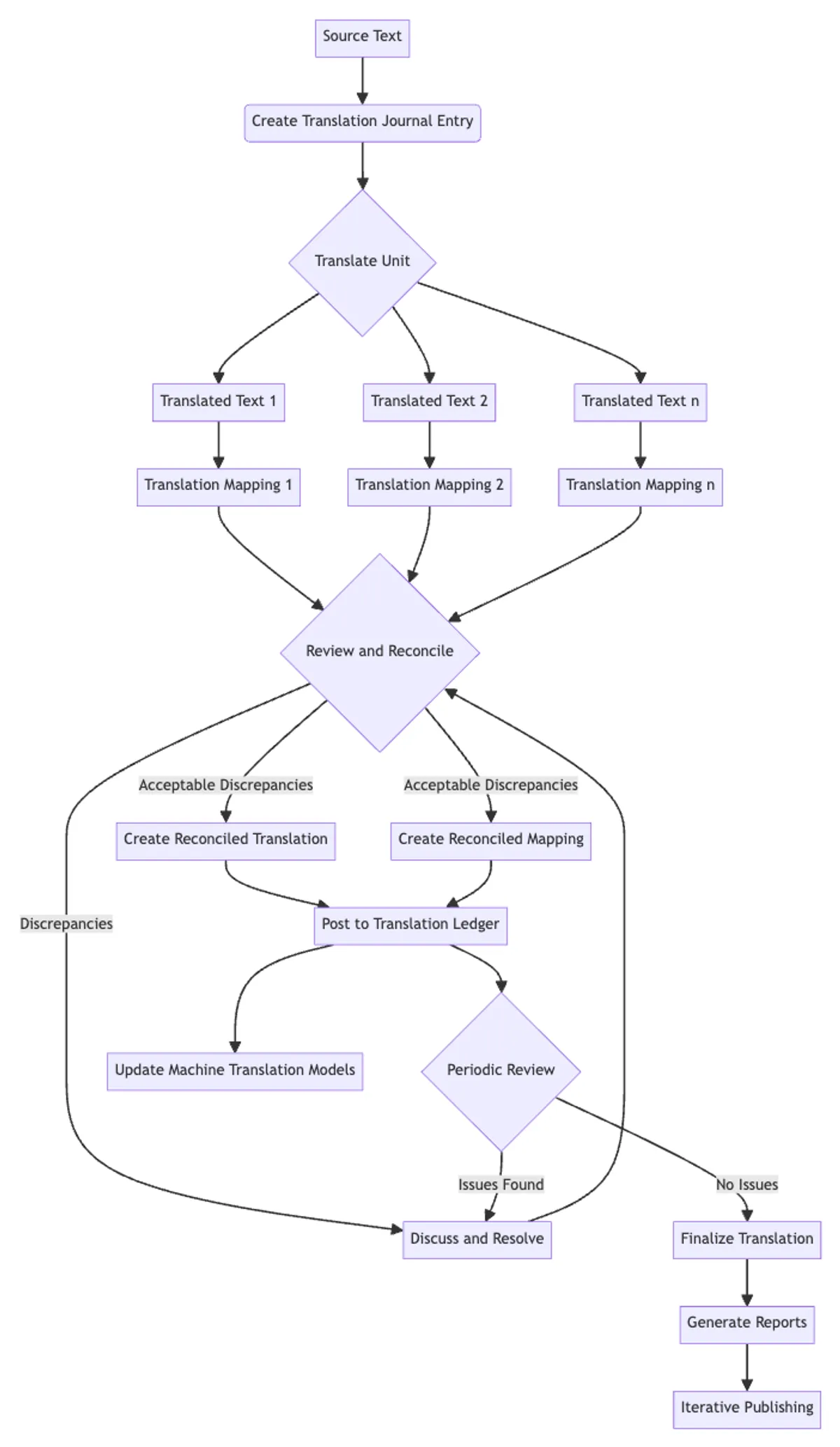Applying Double-Entry Bookkeeping Principles to Bible Translation
#translation
This idea was co-ideated with Ben Scholtens
Double-Entry Translation, or Ledger Translation (LT), is a framework that adapts the principles of double-entry bookkeeping to ensure accuracy, consistency, and a clear mapping between the source and target texts in the Bible translation process.

The framework consists of the following components:
-
Translation Accounts:
- Source Text (ST): The original text, treated as an asset.
- Translated Text (TT): The new translation, treated as a liability.
- Translation Mapping (TM): The mapping between ST and TT, representing the transactions or “translation-actions” for translation-units at multiple levels of granularity (e.g., meaning-based alignments, sliding-window ngram alignments, etc.).
-
Translation Journal: A chronological record of all translation entries, including the source text, multiple translated texts, and their corresponding translation mappings.
-
Translation Ledger: A collection of “posted” translations and their reconciled mappings, perhaps organized by book, chapter, and verse, representing the accepted translations and alignments.
-
Translation Process:
- One or more translators create journal entries for each translation unit, including the source text (ST), multiple translated texts (TT1, TT2, etc.), and their respective translation mappings (TM1, TM2, etc.).
- Each translation mapping “debits” the source text and “credits” its corresponding translated text, ensuring a balanced and accurate representation of the translation process. Anything credited to the translation can be debited from the source text, and vice versa for full accountability.
-
Reconciliation and Review:
- Editors review the translation journal entries to ensure accuracy and consistency between the source text, multiple translated texts, and their mappings.
- Discrepancies or issues are discussed and resolved, with the goal of creating a reconciled translation—there can be more than one accepted version for any unit, though a published version might be expected to arrive at a single preferred version for a given project—and mapping for each translation unit.
- The reconciled translation and mapping are “posted” to the translation ledger, linking to the relevant journal entries.
- The ledger entry represents a balanced translation that accounts for the credits, debits by way of the linking or mapping between the source and target texts.
-
Reporting and Iterative Publishing:
- Regular reports summarize translation progress, including the number of translation units processed, reviewed, reconciled, and posted to the ledger.
- These reports can be used as a mechanism for iterative publishing, allowing the translation team to share their work in progress and gather feedback without the pressure of producing a finished product.
- Iterative publishing helps maintain transparency, engage stakeholders, encourage believers, and refine the translation over time.
-
Breaking Down Translation Units and Machine Translation:
- The LT Framework enables the translation process to be broken down into smaller, manageable units, such as phrases or sentences, rather than focusing on larger segments like paragraphs or chapters.
- As the translation progresses, the growing dataset of source texts, translated texts, and their mappings can be used to train and refine statistical and neural machine translation models.
- These models can provide suggestions and assistance to translators, improving efficiency and consistency as the project grows.
By allowing for multiple translations and mappings to be submitted via the journal, and then reconciling them into balanced ledger entries, the LT Framework promotes collaboration and ensures that the final translation is a result of careful consideration and consensus.
The linking of ledger entries to their corresponding journal entries maintains a clear “audit trail” and allows for a comprehensive understanding of the translation process. This approach enhances transparency, accountability, and the overall quality of the translated text. More intriguingly, the LT Framework is a decentralized, collaborative, and iterative framework that does not rely on external expertise, and that can adapt to various translation projects, languages, and contexts, making it a valuable tool for emerging Bible translation projects and teams around the world.
Addendum: Simplified Implementation of Double-Entry Principles
While the full Ledger Translation Framework promises a robust approach to managing translations, a simplified implementation can still offer many of the benefits of double-entry principles.
In this simplified approach, translations are stored as both “journals” and “ledgers”:
-
Translation Journal: The journal represents the raw, unadulterated translations, capturing the direct output from the translators. This includes the source text, the translated text, and any relevant metadata or notes.
-
Translation Ledger: The ledger represents the reviewed, reconciled, and approved translations. It contains the final, polished versions of the translated text, along with the corresponding source text and metadata.
The process flow for this simplified implementation would be as follows:
-
Translators create entries in the Translation Journal, providing their raw translations for each unit of text.
-
Editors and reviewers assess the journal entries, making corrections, and ensuring consistency and accuracy.
-
Once a translation is approved, it is transferred from the Translation Journal to the Translation Ledger, becoming an official, accepted version of the translation. Ledgers are versioned, journals are not - though they may be versioned via source control management software.
-
The Translation Ledger serves as the authoritative source for the translated text, while the Translation Journal maintains a record of the original translations and the process of refinement. Because the ledger is versioned, translators are able to make updates to the journal entries, which can then be reviewed and re-posted to the ledger under a new version number. Theoretically, each verse may be versioned, or each chapter, or each book, or the entire translation.
By maintaining both a journal and a ledger, this simplified approach still provides transparency, accountability, and a clear audit trail for the translation process. It allows for the tracking of changes and the preservation of the original translator’s work, while also presenting a clean, approved version of the text for use and distribution.
While not as comprehensive as the full Ledger or Double-Entry Translation Framework, this simplified implementation still captures the core principles of double-entry bookkeeping and can be a valuable tool for managing translations in a more streamlined manner while maintaining transparency regarding the source texts used, the translation process, and the published and versioned translated text.
